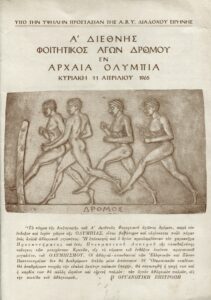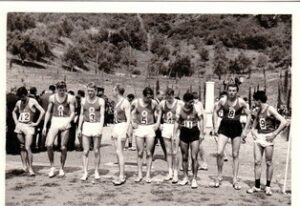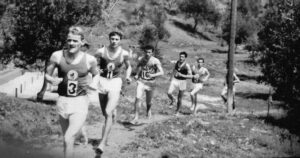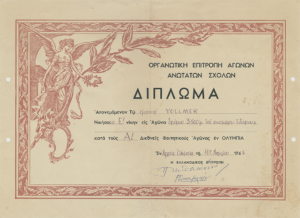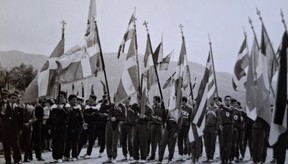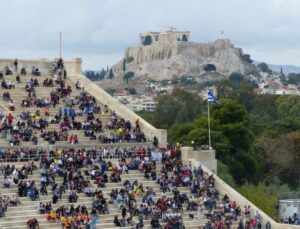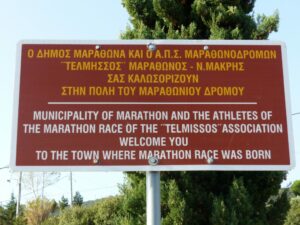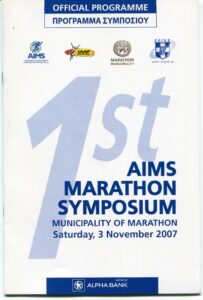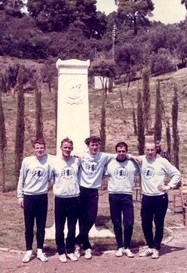
The team from Freie Universität Berlin (FU Berlin) in Olympia 1965 - (from left to right:) Manfred Heyn, Hartmut Lehmann, winner Bodo Tümmler with the winning olive wreath on his head, Dierk Vollmer and Horst Milde - Photo: private
60 years ago: Historic student cross country race in 1965 between the universities of Athens, Belgrade, Rome and Berlin at the historic site in Olympia, Greece. Horst Milde reports
On Sunday, April 11, 1965, an international student cross-country race between four universities took place at the historic Greek site of Olympia. The universities of Athens, Belgrade, Rome, and Berlin were invited.
Front page of the four-page program for the cross-country race on April 14, 1965 – photo: Horst Milde
The Free University of Berlin (FU Berlin) sent a team of 5 runners to Olympia, led by the sports department of the FU Berlin.
The extraordinary anniversary of a running event 60 years ago at a historic site of sports history is worth commemorating. It took some detective work to find all five runners of the 1965 Berlin team still “alive”.
The FU team consisted of Bodo Tümmler, who later became European champion in the 1500m and third in the 800m (Budapest 1966) and Olympic bronze medalist in Mexico (1968), the sports representative of the FU Berlin Hartmut Lehmann (BSC), Dierk Vollmer (OSC), Manfred Heyn (Z 88) and Horst Milde (SCC).
Hartmut Lehmann, the sports officer at the FU Berlin, was a godsend, at least for me and for the sport of running. He organized the FU Berlin team’s (10 runners) trip to a student cross-country race in Le Mans, France, in 1964, which they went on to win. But this race was the source of inspiration and trigger for the first Berlin Cross-Country Run of the FU Berlin on November 8, 1964 at Teufelsberg https://news.germanroadraces. de/60-jahre-berliner-cross-country-lauf-1964-am-9-november-2024-im-grunewald-julius-hirsch-sportanlage-harbigstrasse-40/ and ultimately also for the BERLIN MARATHON on October 13, 1974 https://news.germanroadraces. de/der-berlin-marathon-und-seine-kurz-geschichte-von-horst-milde/.
The trip to Olympia in Greece in 1965 with the team from the Free University of Berlin (5 runners) turned out to be a piece of luck for AIMS with the AIMS Marathon Symposium and for the Athens Classic Marathon, which developed from a niche event into a huge event.
For Milde and Tümmler, the years 1964 and 1965 were also successful in terms of track and field. They each became German champions with the 3 x 1000 m relay team of SCC (with Gerhard Kopp). Tümmler later succeeded as a multiple German champion in the middle distances in Budapest in 1966 over 1500 m and also in Mexico in 1968.
From today’s perspective, the route to Olympia was a very special adventure – with the Deutsche Bundesbahn from Berlin via Munich, Bologna to Brindisi, almost the southernmost tip of Italy. The journey took more than twenty hours.
The next leg of the journey was by ferry from Brindisi to Patras on the Peloponnese, then by bus to Olympia. On the way to Olympia, flyers were thrown out of the moving bus to advertise the event in Olympia at every town that was passed through.
Bodo Tümmler came from Berlin-Tempelhof airport to Athens. He was a participant in the indoor international match against the USA in the former Deutschlandhalle, which no longer exists today. Bodo Tümmler won the 1500 m in 3:46.3 against Jim Grelle (USA) 3:46.6.
The Xenia Hotel in Olympia was the athletes‘ shared accommodation. We were looked after by friendly and informative staff from the German Archaeological Institute (DAI), which has been uncovering the sanctuary in systematic excavations since the 19th century. The Temple of Zeus at Olympia is one of the most famous monuments of Greek architecture and once housed the gold and ivory statue of Zeus created by Pheidias, one of the Seven Wonders of the World.
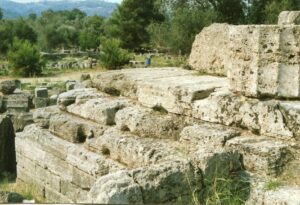
Remains of the Temple of Zeus at Olympia – Photo: Horst Milde
The guided evening and night-time walks through the terrain of Olympia near the Kladeoa stream had a very unique and impressive atmosphere that you won’t forget.
On the day of the competition, April 11, 1965 (Sunday), the teams gathered and marched in with their national flags – Bodo Tümmler carried the German flag – onto the square with the stele of Pierre de Coubertin, the founder of the 1896 Olympic Games. A great deal of importance was attached to ceremonial representation, as high-ranking guests were also in attendance

Team of Freie Universität (FU Berlin) with f.l. : Bodo Tümmler, Horst Milde, Hartmut Lehmann, Dierk Vollmer and Manfred Heyn – photo: private
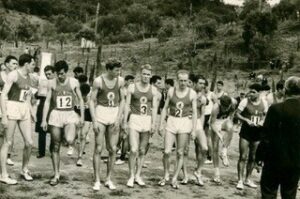
Shortly before the start– Bodo Tümmler (1), Hartmut Lehmann (3) – Horst Milde (2) – Dierk Vollmer (halb verdeckt) – Manfred Heyn – Foto:private
Bodo Tümmler (1) – Hartmut Lehmann (3) – Horst Milde (2) – Dierk Vollmer (5) – Manfred Heyn (4) – photo: private

Shortly after the start – Bodo Tümmler (1) – iin the background (left) : Hartmut Lehmann (3) – photo: private
Hartmut Lehmann (3) in front of Bodo Tümmler (1), fifth Dierk Vollmer – photo: private
The race in a very hilly terrain was won by Bodo Tümmler. He took turns in the lead with Hartmut Lehman (Berlin), followed by three fellow students from Serbia. Dierk Vollmer (Berlin) came in fifth, Hartmut Lehmann seventh, Horst Milde ninth and Manfred Heyn tenth.
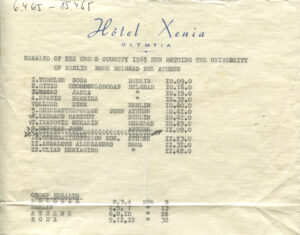
The “results list” of the university cross-country race in Olympia – Photo: Horst Milde
The team ranking was won by the University of Belgrade, with the Free University of Berlin (FU Berlin) in second place
The certificate for Dierk Vollmer in fifth place – Photo: Gerd Steins
The parade of flags at the award ceremony – Photo: private
Dejan Nikolic, long-time race director of the Belgrade Marathon, is “”searching“” for the victorious participants of the University of Belgrade team to see if they are still alive and – similar to the Berlin runners – to commemorate this unique 60th anniversary on April 11, 2025. Inquiries about former participants have also been sent to the universities of Athens and Rome.
Before the award ceremony, there was an official flag parade, with the teams marching out and speeches. The winner, Bodo Tümmler, had a wreath of olive branches placed on his head. An official photographer took a picture of him with this historic victory trophy – and the next day this victory photo was on sale in the souvenir store in Olympia.
The return journey for us was via Athens. In the Athens Olympic Stadium from 1896, the Panathinaiko Stadium, there was a building at the top of the stadium where we were accommodated. We trained on the track, which is shaped like a horseshoe, with a very tight curve radius and about 300 meters long. The stadium is clad entirely in marble. From the stadium you have an incomparable view of the famous Acropolis.
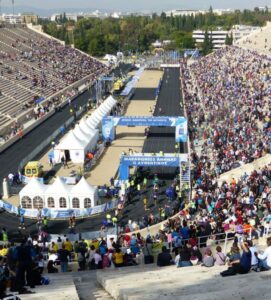
The current Athens Marathon has its finish line in the old Panathinaiko Stadium from 1896 – Photo Horst Milde
View of the Acropolis from the Panathinaiko Stadium – Photo: Horst Milde
The Berlin participants of the 1965 student cross-country race, Tümmler, Heyn and Milde, will meet in private at Horst Milde’s home on April 11, 2025 to celebrate the anniversary, drink coffee and exchange memories. Lehmann and Vollmer had already set other dates for themselves in advance.
For the undersigned, however, there was a reunion with Olympia in 1986 during a family vacation in Greece. With the family and the children, it was a “must” to see Olympia again. Of course, the children did not share the “sublime” and historical feelings and references to this sporting and ancient place, but it was a rewarding, sensual and slightly wistful reunion.
I combined the 2004 Olympic Games in Athens with a visit to the IOC Museum in Marathon, the legendary namesake of our sport and the start of the marathon. In the new small museum in Marathon, the IOC had displayed the Olympic marathon races from 1896 onwards, as well as the New York City Marathon and the Rotterdam Marathon, but not the BERLIN MARATHON. To make up for this “mistake”, I later sent the museum a large package from Berlin with information, souvenirs, race numbers. medals and posters from the BERLIN MARATHON, which at that time already had over 40,000 participants.
Welcome sign of the city of Marathon – Photo: Horst Milde
About a year later, the mayor of the city of Marathon, Spyros N. Zagaris, contacted me and apologized that “he had only just found the package and my letter”. He told me that he would come to Berlin with a delegation and present me and the “Forum for Sports History” – the Berlin Sports Museum – with an olive wreath from Marathon as an act of solidarity between the Marathon cities.
A reception was prepared for the delegation from Marathon – together with the Berlin State Sports Association – statements were exchanged and later the bronze olive wreath, which the winners receive, was ceremoniously presented to the President of the Sports Forum for Sports History, Gerd Steins, in the museum in Berlin’s Olympic Park.
The bronzed olive wreath from Marathon in the display case in Berlin – Photo: Gerd Steins
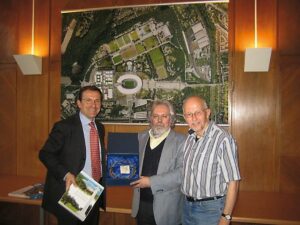
The Mayor of Marathon (left) Spiros N. Zagaris hands over the bronzed olive wreath to Gerd Steins (center), President of the Forum for Sports History – Marathoneum – Horst Milde (right) founder of the BERLIN-MARATHON – Photo: Sabine Milde
I was invited by SEGAS, the Greek Athletics Association, to a meeting in Athens in 2007. It was the beginning of a successful collaboration. I explained to the organizers that it is incomprehensible that the Athens Marathon only has around 3000 – 5000 participants at its annual event, while Berlin already has over 40,000 participants. The reputation of the term “MARATHON” is legendary worldwide, but the population in Greece had a recognizably reserved attitude towards running, to say the very least.
The meeting in Athens had consequences: The AIMS Marathon Symposium in Marathon was initiated and I was a consultant to the Athens Marathon for more than 10 years, which developed phenomenally.
The brochure of the 1st AIMS Marathon Symposium in the city of Marathon – Photo: Horst Milde

The introductory statement as chairman of the AIMS Marathon Symposium – Photo: Horst Milde
The coordinator and moderator of the symposium, as well as of the Athens Marathon “in front of and behind the scenes” was Makis Asimakopoulos, who had everything in hand and operated happily together with Kostas Panagopoulos, President of the Athens Classic Marathon. One of the main speakers in 2007 was Prof. Wolfgng Maennig of the University of Hamburg, who spoke on the topic: “The economic impact of the Classic Marathon events on the organizing cities and local communities”.
The AIMS Marathon Symposium 2007, first directly in Marathon and later in Athens, was a success for the Athens Classic Marathon and AIMS. Many AIMS members from all over the world came to this annual event. The Greek organizers knew how to turn it into a real folk festival with a ceremony at the tumulus (burial site of the fallen Athenians), where at least one minister always gave a speech. This was followed by an ancient theater performance. It is not possible to do more historical reappraisal of history at the ancient site, but it shows the attachment of the population to their great past and to sport in the present day.
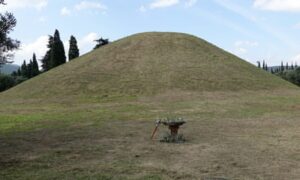
The tumulus of the fallen Athenians – Photo: Gerd Steins, Berlin
The evening was followed by a GALA in a packed theater with LIVE television coverage and the AIMS award ceremony for the world’s best marathon runners and other deserving personalities from the running world, as well as a reception afterwards.
Back in 2007, AIMS in Marathon received an extremely rare replica of the venerable “Bréal Cup” from SEGAS, the Greek Athletics Federation, which was awarded to the winner Spyridon Louis of the first Olympic Marathon in Athens in 1896. This replica was then immediately “passed on” to the AIMS Marathon Museum of Running in Berlin. The original Bréal Cup was auctioned off at Christie’s in London on April 18, 2012 and is now on display as national cultural heritage at the Stavros Niarchos Foundation in Athens.
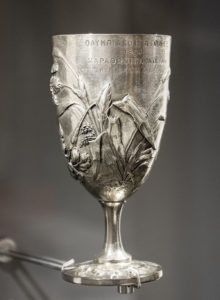
The original “Michel Bréal Cup” – named after the creator of the marathon – in the “Stavros Niarchos Foundation” Museum – Photo: Gerd Steins
The AIMS headquarters are located in Athens, OACA Olympic Complex, Av. Spyros Louis, practically at the birthplace of the marathon.
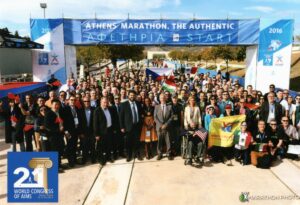
The participants of the 21st AIMS World Congress 2018 in Athens – here united on the starting track in Marathon. In the middle is AIMS President Paco Borao, Valencia – Photo: Francis Kay – MarathonPhoto
The five runners from the FU Berlin who competed in the 1965 Olympics could not have imagined the developments in running and the importance of this sport 60 years later. The Freie Universität Berlin initiated many developments and activities through its “running ambassadors” by traveling to Le Mans in 1964 and the Olympia in 1965.
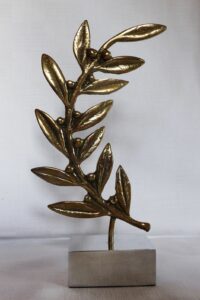
Horst Milde received the honorary award from the organizers of the Athens Classic Marathon (SEGAS) for his many years of support and advice. – Photo: Gerd Steins
The city of Marathon presented him with a similar award, not only for his personal commitment, but also for his digital appeals for donations for the population on the occasion of the fire disaster in the villages along the marathon route. On the website of German Road Races (GRR) you can find over 1000 posts about the Athens Marathon with all kinds of topics.
There are currently no large numbers of middle and long-distance runners involved in competitive sport at the FU – the FU Berlin Sports Institute at Hittorfstrasse 16 in Berlin Dahlem was unfortunately closed a long time ago, but the “General German University Sports Association” (adh) has named the Freie Universität Berlin (FU Berlin) as University of the Year 2024.
This is in recognition of Freie Universität Berlin’s outstanding commitment to university sports, both in competitive sports and in health promotion and education, explained the adh.
The FU’s “figurehead” in the field of running is now track and field athlete and middle distance runner Caterina Granz, gold medal winner of the 2019 FISU Games in Naples and adh Sportswoman of the Year 2019.
But the “figurehead” for running and for the Freie Universität Berlin is now also the Vice Chancellor of the FU Berlin, Prof. Dr. Sven Chojnacki, who has already been unrecognized several times the Athens Marathon.
The adh’s decision to award this title to the FU Berlin is based on a number of impressive achievements and initiatives that have been realized in recent years, such as the “Campus Run” running event for members of the FU. This race has been advertised and reported on this GRR website from the very beginning.
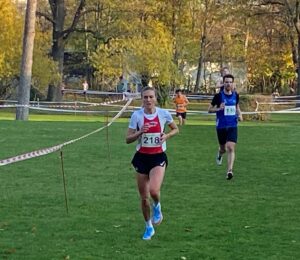
Caterina Granz at a cross-country race in Berlin in the equestrian stadium of the Olympic Park – Photo: Horst Milde
Looking back on the 60th anniversary of the university cross-country race at the historic site in Olympia in 1965 has its own significance for those involved and shows the positive initiatives it has triggered in Greece and Germany.
On April 11, 2025 there will be a reunion for the 1965 FU veterans at the coffee table in Berlin-Tempelhof!
Horst Milde
—
—
YouTube-Video von Prof. Helmut Winter mit Horst Milde über die Historie des BERLIN-MARATHON (1974) und den Crosslauf am Teufelsberg (1964):
https://www.youtube.com/watch?v=sEGve18Drf8
 EN
EN
